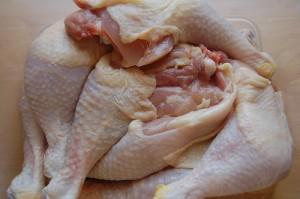
A recent study found that chicken sold at Farmers’ Markets is more likely to carry salmonella, leaving many people wondering if doing the right thing for the environment — buying local and sustainably-raised meats — means doing the wrong thing for their families’ health.
The study, which compared prevalence of Salmonella and Campylobacter on chickens from large grocery stores and from farmers’ markets, found significantly higher rates of contamination on the farmers’ market chickens.
“The results from this study demonstrate the need to develop food safety training for poultry vendors at farmers’ markets in order to improve the safety of these products for public consumption,” the authors said.
I would argue it demonstrates the need for food service people and home cooks to learn about food safety. Salmonella and Campylobacter are the leading cause of the 3.6 million illnesses caused by bacterial foodborne pathogens, the study’s authors noted.
According to the New York Times, which wrote about the study, poultry farmers that process fewer than 20,000 birds a year are not subject to Department of Agriculture inspections. The writer speculated that the lack of oversight may be a contributing factor.
It’s certainly worth considering why chicken from farmers’ markets might carry harmful microbes. In their discussion, the Penn State scientists wrote, “The information gathered in this study may be of interest to regulatory officials who are responsible for local, state or federal regulations directed at farmers’ markets and for educators who are interested in implementation of food safety training programs.”
But while the farmers’ market chickens did show much greater prevalence, (28 percent and 90 percent of chicken from farmers’ markets, tested positive for Salmonella and Campylobacter, respectively, compared with 20 percent and 28 percent of conventionally processed organic, and 8 percent and 52 percent of nonorganic chicken), the numbers almost don’t matter.
If you have a fifty-fifty shot of getting food poisoning if you aren’t handling your conventional, grocery-store chicken properly, are you going to be any less careful than if you were handling chicken with a 90 percent chance of making you sick?
I hope not.
Study author Joshua Scheinberg also told the Times he did not want to discourage people from shopping at farmers’ markets.
Both sellers and buyers “have to make sure they’re handling the products properly, keeping them cold, making sure they’re not cross-contaminating tabletops or kitchen implements. Yes, we found in a small study higher levels of these pathogens. But these would be destroyed if properly cooked to 165 degrees,” he said.
So, don’t worry about where you buy your chicken — do, actually, just not because you’re scared of Salmonella. Instead, focus your anxieties on whether you brought it up to temperature and washed your counter with hot, soapy water.
And maybe spare a thought for how your chickens were raised…




